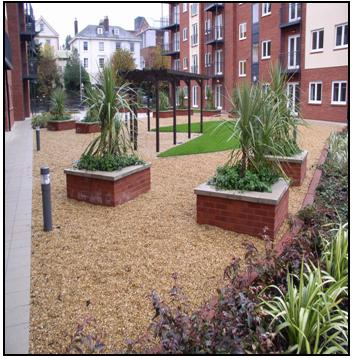
Traditional landscaping and current landscape maintenance practices, while frequently meeting human needs and aesthetics, sometimes have unintended harmful impacts.
The clearing of native woodlands and other natural habitats for urban/suburban growth and subsequent planting of grounds with vast lawns and manicured arrangements of exotic ornamental plants can place a heavy toll on environmental and human health.
Interesting Facts:
- Gasoline-powered landscape equipment (mowers, trimmers, blowers, chain saws) account for over 5% of our urban air pollution.
- Residential application of pesticides is typically at a rate 20 times that of farmers per acre; it results in many unintended results.
- Yard wastes (mostly grass clippings) comprise 20% of municipal solid waste collected and most still ends up in landfills.
- A lawn has less than 10% of the water absorption capacity of a natural woodland - a reason for suburban flooding.
Negative Effects of Traditional Landscaping
This type of a landscape requires extensive use of mechanical equipment and consumption of natural resources (water and fossil fuels), frequent application of fertilizers and pesticides, and the generation of significant quantities of solid waste. As a result, surface and ground waters are being polluted; destructive flooding is more commonplace; a neighborhood's tranquility and air quality can be compromised by noisy, polluting landscape equipment; and our landfills are being consumed by yard waste. Furthermore, the bio-diversity of our ecosystems is suffering from the introduction of invasive exotic landscape plants.
Balancing Landscaping and Environment
We can learn to balance our needs with those of the environment. Beneficial landscaping attempts to do just that. And, in addition to protecting and conserving our natural resources, this method of landscaping can save considerable time and money through reduced maintenance requirements.
Natural or Native Landscaping
Beneficial landscaping, sometimes referred to as natural or native landscaping though it is more than that, contains a number of principles that revolve around balancing our needs and sense of beauty with those of nature (our ecosystems) because, in the long run, they are interrelated.
These principles are:
- PROTECT EXISTING NATURAL AREAS to the greatest extent possible (woodlands and wetlands, stream corridors and meadows).
- SELECT REGIONALLY NATIVE PLANTS to form the backbone of the landscape. Select appropriate plants for each particular site (each plant has its unique requirements and most sites have a variety of conditions). While there's not usually a problem with occasional use of exotic plants, native plants have evolved to local conditions over millions of years and form an integral part in the life cycles of the local wildlife; they also give an area its unique sense of place.
- REDUCE USE OF TURF. Instead, install woodland, meadow or other natural plantings. Where lawns are needed (such as play areas), follow best management practices available from your county's cooperative extension agent to reduce harmful impacts and use composting mowers.
- REDUCE USE OF PESTICIDES, practice integrated pest management. Again, cooperative extension agents can help with natural alternatives to pesticides.
- COMPOST AND MULCH ONSITE to eliminate solid waste. Generate a free mulch - a soil additive that can replace the need for most fertilizers.
- PRACTICE SOIL AND WATER CONSERVATION. Stabilize slopes with natural plantings, mulch around plants, and install drought- tolerant species.
- REDUCE USE OF POWER LANDSCAPE EQUIPMENT. Shrinking the size of the lawn and planting appropriate native species in less formal arrangements will reduce the need for extensive use of power equipment.
- USE PLANTINGS TO REDUCE HEATING/COOLING NEEDS. Deciduous trees planted appropriately along the south sides of buildings can reduce air conditioning costs by up to 20%; in winter they allow the sun's rays to warm buildings. Coniferous trees planted to block prevailing NW winter winds can reduce heating costs. Trees planted to shade paved areas reduce the summer heat-island effect that makes parking lots so inhospitable.
- AVOID USE OF INVASIVE EXOTICS which out compete native plants and result in declines in bio-diversity. Examples include: Norway maples, kudzu, purple loose strife, Japanese honeysuckle and multi flora rose.
- CREATE ADDITIONAL WILDLIFE HABITAT to partially compensate for land lost to urban/suburban sprawl. This is especially important along streams where the vegetation can filter runoff, aid in flood control, and provide wildlife corridors.
The following useful ideas are from "Energy-Efficient and Environmental Landscaping - Cut Your Utility Bills By Up to 30 Percent and Create a Natural, Healthy Yard" by Anne Simon Moffat, Marc Schiler, and the staff of Green Living.
Aspects to Consider for Natural Landscaping
Landscaping can change the micro climate around a building by 20 - 25 degrees F. According to the US Dept. of Energy, energy-efficient landscaping can save up to 30% on home heating bills. Savings for cooling can be even more. Tests in Florida showed a 50% reduction in air conditioning costs. Most people can save at least a few hundred dollars a year by properly reworking their yard. This can also increase the value of your home since buyers will pay more for a house with low utility bills. There are a number of aspects to consider including sunlight, water, soil, and color of your house.
Sunlight
Plants interact with solar radiation by blocking sunlight (creating shade) and absorbing heat. In temperate climates, such as ours, deciduous plants in full leaf are generally the best interceptors of direct solar radiation. And, in the winter, when their leaves have been shed, they allow in much desired sunshine. Landscaping should block or filter summer sun and permit winter sun to reach most living areas. Dense trees can block up to 95% of sunlight and 75% of its heat. Consider the size and shape of the shadow a plant will cast. At midday a vine-covered wall is cooler than a bare wall. If you don't have mature trees, consider planting vines on a trellis.
Water
Water also tempers heat. Even a small pond can help. Plants can also alter micro climates by intercepting precipitation. Only 60% of rain falling on a pine forest reaches the ground. Because trees intercept and slow down water movement they also help to control runoff and erosion. Plant water-thrifty plants, often natives that are suited to the climate. Group together plants with similar water needs. During droughts raise the cutting level of your lawnmower to between 2 and 3 inches. This causes less stress and encourages deep root growth.
Soil
Berms, small manmade mounds of earth, can block sun, obstruct winds, insulate, and control noise. Mounding soil against a wall can provide insulation, however, the soil must be well-drained. Mounding must be avoided if it will allow termites or carpenter ants to enter the building. Sandy soil drains too quickly and doesn't provide much in the way of nutrients. Water tends to run off of clay soil. The best soil is a mix of clay, sand & silt (loam).
Color
Paved blacktop can raise temperatures 20 degrees F over adjacent grassed areas. House color also influences temperatures. White roofs keep houses cooler in summer.
Note: These suggestions may promote algae growing on the roof and side walls, and mold and pollen on the plants next to the house which could promote allergies. Be sure to consider all of the factors involved in your planning process so that your outcome will be more successful.
HUMAN BENEFITS FROM BENEFICIAL LANDSCAPING
By adopting and advocating beneficial landscaping, wildlife isn't the only benefactor. Here's how we can all benefit.
- Safer environments for our families
- Quieter neighborhoods (from reduced use of power equipment)
- Water conservation that benefits the homeowner and community
- Reduced flooding and costs for storm water management
- Greater opportunities to enjoy nature
- Reduced landscape maintenance labor/more free time
- Reduced landscape maintenance costs
- Less strain on municipal waste collection and water treatment
- Cleaner water bodies for fishing, swimming, drinking
- Lower heating and cooling bills
Beneficial landscaping is appropriate for public lands; highway right-of-ways; commercial, industrial and other private grounds; and, of course, residential properties. Its benefits are most pronounced where whole communities or other large landowners adopt the principles. However, even individual homeowners can reap significant rewards.
Public officials are encouraged to: install beneficial landscaping on new and existing public sites; adopt or amend local weed ordinances and development regulations so as to encourage natural landscaping; provide information about beneficial landscaping to residents, businesses, developers and civic organizations; identify natural areas within the community that need to be preserved or restored; and sponsor demonstration projects and award creative efforts.
 Print
Print Email
Email








